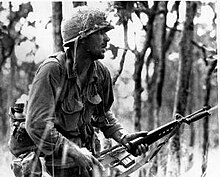Rick Rescorla
Richard Cyril Rescorla (May 27, 1939 – September 11, 2001) was a British-American soldier, police officer, educator and private security specialist.
As the director of security for the financial services firm Morgan Stanley at the World Trade Center,[3] Rescorla anticipated attacks on the towers and implemented evacuation procedures that were credited with saving thousands of lives.
When a professional boxing match was scheduled between a British boxer and a U.S. heavyweight contender named Tami Mauriello, his friends backed the Briton.
[4] At the time, Britain practiced conscription (known as National Service), which required every young man to serve for two years in the Armed Forces.
He enlisted in the British Army in 1957, training as a paratrooper with the Parachute Regiment and then serving with an intelligence unit in Cyprus during the EOKA Cypriot insurgency[5] from 1957 to 1960.
It was during the latter post that he met and forged a "life-altering friendship" with American soldier Daniel J. Hill, who encouraged Rescorla to join the U.S. Army[4] after he chose to accept discharge from the police rather than turn his guns on fellow white colonists resisting independence.
Despite this tough image, according to his second wife and widow Susan Rescorla in her book, Touched by a Hero, music was "so central" to Rick's life that he sang to his troops in Vietnam to calm them – something he would later employ during 9/11 evacuations.
[5] In the 1965 Vietnam battle, Rescorla sang the Australian version of "Wild Colonial Boy" to give confidence to his troops.
[2] In April 2001, Rescorla was chosen for induction into the Infantry Officer Candidate School Hall of Fame and was invited to participate in ceremonies at Fort Benning.
[4] After the 1988 bombing of Pan Am Flight 103 over Lockerbie, Scotland, Rescorla worried about a terrorist attack on the World Trade Center.
[15] Because his old American friend from Northern Rhodesia, Daniel Hill, was trained in counterterrorism, in 1990, Rescorla asked him to visit the World Trade Center to assess its security.
"[4] That year, Rescorla and Hill wrote a report to the Port Authority of New York and New Jersey, which owns the site, insisting on the need for more security in the parking garage.
Although no arrests had yet been made in the case, Rescorla suspected that the bomb had been planted by Muslim terrorists, probably Palestinians, or that an Iraqi colonel of engineers might have orchestrated the attack.
[15] Rescorla wanted the company out of the building because he continued to feel, as did Hill, that the World Trade Center was still a target for terrorists and that the next attack could involve a plane crashing into one of the towers.
[17] He recommended to his superiors at Morgan Stanley that the company leave Manhattan office space, mentioning that labor costs were lower in New Jersey and that the firm's employees and equipment would be safer in a proposed four-story building.
[4] Feeling that the authorities lost legitimacy after they failed to respond to his 1990 warnings, he concluded that employees of Morgan Stanley, which was the largest tenant in the World Trade Center, could not rely on first responders in an emergency and needed to empower themselves through surprise fire drills, in which he trained employees to meet in the hallway between stairwells and go down the stairs two by two to the 44th floor.
[15] Rescorla's strict approach to these drills put him into conflict with some high-powered executives, who resented the interruption to their daily activities, but he nonetheless insisted that these rehearsals were necessary to train the employees in the event of an emergency.
system urging people to stay at their desks, and before United Airlines Flight 175 would strike the South Tower at 9:03 A.M.,[22] Rescorla ignored the announcement, grabbed his bullhorn, walkie-talkie and cell phone, and began systematically to order the roughly 2,700 Morgan Stanley employees in the South Tower to evacuate, in addition to the employees in WTC 5, numbering around 1,000.
While watching the news coverage, in a phone call to his best friend, Dan Hill, Rescorla said, "The dumb sons of bitches told me not to evacuate," and, "They said it's just Building One.
A total of 13 Morgan Stanley employees died in the September 11 attacks,[28] including Rescorla, his deputies Wesley Mercer and Jorge Velazquez, and security guard Godwin Forde, who had collectively stayed behind to help others.
He underwent treatment, which involved painful injections directly into his stomach every month and taking prescribed medications that dehydrated him and caused his body to swell.
Susan first spoke to him to ask him why he was jogging barefoot, a practice common in Northern Rhodesia, where few natives wore shoes and which he had adopted out of curiosity.
Although he had given some interviews to his Vietnam commander, Harold Moore, for his 1992 book, We Were Soldiers Once… And Young, Rescorla chose not to read it when he saw that its cover featured a combat photograph of him.
"[4] Nevertheless, Rescorla's activities during the September 11 attacks were quickly brought to national attention by the news media, including a detailed account by Michael Grunwald in the October 28, 2001, edition of The Washington Post of Rescorla's life and "epic death, one of those inspirational hero-tales that have sprouted like wildflowers from the Twin Towers rubble.


